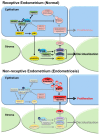Progesterone and Estrogen Signaling in the Endometrium: What Goes Wrong in Endometriosis?
- PMID: 31387263
- PMCID: PMC6695957
- DOI: 10.3390/ijms20153822
Progesterone and Estrogen Signaling in the Endometrium: What Goes Wrong in Endometriosis?
Abstract
In the healthy endometrium, progesterone and estrogen signaling coordinate in a tightly regulated, dynamic interplay to drive a normal menstrual cycle and promote an embryo-receptive state to allow implantation during the window of receptivity. It is well-established that progesterone and estrogen act primarily through their cognate receptors to set off cascades of signaling pathways and enact large-scale gene expression programs. In endometriosis, when endometrial tissue grows outside the uterine cavity, progesterone and estrogen signaling are disrupted, commonly resulting in progesterone resistance and estrogen dominance. This hormone imbalance leads to heightened inflammation and may also increase the pelvic pain of the disease and decrease endometrial receptivity to embryo implantation. This review focuses on the molecular mechanisms governing progesterone and estrogen signaling supporting endometrial function and how they become dysregulated in endometriosis. Understanding how these mechanisms contribute to the pelvic pain and infertility associated with endometriosis will open new avenues of targeted medical therapies to give relief to the millions of women suffering its effects.
Keywords: endometriosis; endometrium; estrogen; infertility; progesterone; progesterone resistance.
Conflict of interest statement
The authors declare no conflicts of interest.
Figures

References
Publication types
MeSH terms
Substances
Grants and funding
LinkOut - more resources
Full Text Sources

